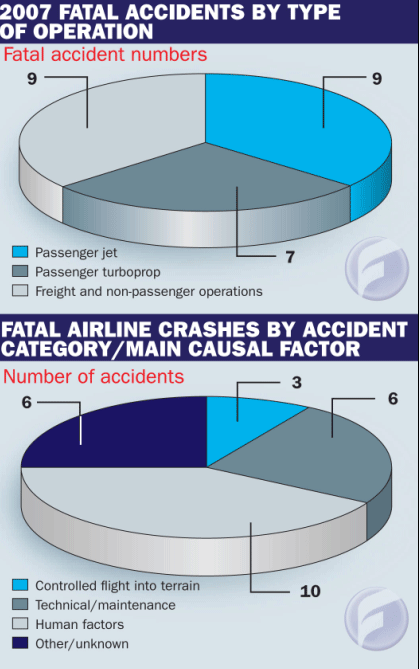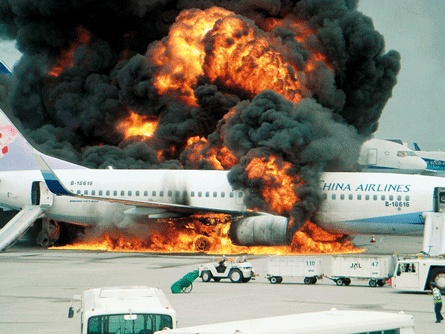Global figures for commercial aviation crashes in 2007 show an all-time low of 25 fatal accidents, and even the number of fatal casualties, at 744, was well below the annual average for the last 10 years. This can be compared with figures for the decade 1998-2007 showing an annual average of 34.7 fatal accidents a year and 870 fatalities. (see chart below).
Accidents and incidents between January and December 2007
Most of the fatal casualties - 583 of them - happened in eight accidents involving scheduled passenger services, and all these flights were operated by jets (see pie charts below). There were seven fatal accidents to passenger flights operated by turboprop aircraft, but because these are smaller aircraft, the number of fatalities was only 95. Only one piston-engined passenger airliner suffered a fatal accident - a BN Islander in Guyana, in which three people died. Sixty-three people died in nine freighter accidents, all involving turboprop aircraft. There were no accidents to jet-powered freighters, which is rare.
|
|---|
This China Airlines Boeing 737-800 developed a fuel leak near the engine as it nosed up to the stand. All on board escaped safely |
Russian improvement
The International Air Transport Association observes that Russian passenger operations improved dramatically last year compared with a bad 2006, but that figures for Indonesia, southern Africa and Brazil worsened despite already being bad.
The worst accident of the year was the TAM Linhas Aereas Airbus A320 landing disaster at Sao Paulo Congonhas airport which killed 187 on board and 12 people on the ground. Apart from that crash and a Tu-134 landing accident at Samara airport, Russia, that killed six of its 57 passengers, all the accidents to passenger aircraft took place in second or third-world economies or involved aircraft registered in them - usually both.

The largest number of fatal accidents for a single country was in the Democratic Republic of Congo, with six fatal crashes, of which four were cargo flights and two were commuter operations using Let 410 twin-turboprop aircraft. The DR Congo accident picture is worsened by the fact that most cargo flights there carry unauthorised passengers, and one of the accidents involved a crash into a Kinshasa residential area, killing an unknown number of people on the ground.
Indonesia saw two of the year's worst fatal accidents involving passenger jets - an Adam Air Boeing 737-400 and a Garuda 737-400 - and Adam Air suffered such serious damage to one of its fleet after a heavy landing that the aircraft was written off by insurers.
Bad year for indonesia
Indonesia's safety performance, consistently in the lower league for 25 years, was particularly bad in 2007. Adam Air started the year with an accident on 1 January in which a Boeing 737-400 was lost over the sea near Sulawesi with no survivors. As the aircraft was lost in deep water, the accident cause may never be known for certain, but it was during cruise in an area where tropical storms had been reported, and the serviceability of the aircraft's weather radar is unknown.
Adam Air saw another landing in which one of its 737s was badly damaged, and Garuda suffered the fatal loss of a Boeing 737-400 that, according to preliminary reports by investigators, landed 80kt (150km/h) too fast at Jogjakarta with flaps set only to 5degrees, and overran the runway, catching fire and burning out. The co-pilot had called for the captain to go around but he did not.
The year saw the destruction of 11 more eastern bloc-built turboprops in fatal accidents, seven of them old Antonovs ranging from An-12s to an An-32. The other four eastern turboprops in fatal crashes were Let 410s, three on passenger operations and one carrying freight a total of 23 people died in them.
In 2005, African Civil Aviation Commission president Tshepo Pheege referred to Antonov turboprops - in the hands of many of the type of operators who fly them in Africa - as "flying coffins", and Uganda banned their use. One of the An-12s that crashed on a freight operation in the Democratic Republic of the Congo had been operating without a certificate of airworthiness since March.
A total of 109 people were killed in Antonov turboprops in 2007, mostly in the DR Congo. Among those who died in the old Antonovs, 54 were killed in two passenger service accidents, and 55 died on five cargo flights. Given that the crew of each cargo aircraft, at most, would have comprised two pilots, a flight engineer and a loadmaster, some of the casualties must have been passengers.

In one of the DR Congo accidents - just after take-off from Kinshasa Ndjili airport - an unknown number of people on the ground died when an El Sam Airlift An-26 plunged into a residential area. This was reminiscent of a January 1996 crash that occurred when a Scibe Airlift An-32 abandoned take-off late in its ground-run at Kinshasa N'Dolo airport when the crew realised it would not get airborne. The aircraft ran over the end of the runway into a marketplace, killing more than 300 people and severely injuring 250.
Looking at fatal accident categories and main causal factors (see chart above), there were only three controlled flight into terrain accident, compared with five in 2006. Accidents in which the primary cause was human factors numbered 10 last year compared with 11 in 2006, and technical/maintenance problems caused six fatal accidents, the same as the previous year. There were six accidents in the other/unknown category. All these categories have been determined from preliminary information, and may be modified when the full reports are published.
Hull losses
According to aviation insurance specialist Aon, airline hull losses for 2007 total 47 aircraft, including all the 25 fatal accidents listed (see accident listings) and many others that did not cause fatalities. Aon says 2007 will be the first year since 2000 in which insurers will make a net loss on airlines, as much because of the nature of the events as the numbers alone. Three of the hull losses were caused by fire or other mishaps to parked aircraft, and one of them involved the China Airlines 737-800 at Naha airport, Japan, that had just taxied up to the stand with passengers on board when a fuel tank was ruptured by a damaged flap track during flap retraction, causing a severe fire (see accidents listing). Not included in this hull-loss tally, because the brand new aircraft had not yet been delivered by the manufacturer to Etihad Airways, was the Airbus A340-600 destroyed when it surged forward into a wall during engine run-up checks at Toulouse.
Increase feared
At the end of September, IATA said it was worried that the number of fatal accidents at that point was such that, if they continued to occur at the same rate up to 31 December, the global hull loss accident rate for scheduled passenger operations using western-built aircraft might increase for the first time in many years. Projected to the end of the year, the rate would have been 0.83 fatal accidents per million sectors, whereas at the end of 2006 the rate was a best-ever 0.65 fatal accidents per million flights.
But there has been only one more serious accident since then, so the rate is expected to be close to the 2006 figure. Neither IATA nor the International Civil Aviation Organisation has yet released a preliminary estimate, however. ICAO says its preliminary traffic figures show airline passenger kilometres flown last year rose by 6.6% over 2006, but the number of sectors operated has not yet been reported.
A series of incidents involving SAS Bombardier Dash 8 Q400 twin turboprops had begun before 2007 but continued during last year with three gear-failure mishaps, including one at Aalborg on 9 September. In the Aalborg incident, the right main undercarriage leg failed to lock down and collapsed on landing. In October, SAS decided to stop operating Q400s because of its varied experience with the type (see 20-20 Hindsight). The question remains whether the problems were related to SAS operations or the type itself, because one of the gear incidents has been traced to a maintenance error, and other Q400 operators report they have not suffered a similar experience.
Finally, IATA says its top human-factors safety priorities are to improve pilot training for handling critical situations in modern aircraft, and better availability of real-time weather information to crews. Its biggest operational concern is runway incursions and excursions.
20-20 Hindsight: accident reports in 2007
Accidents and incidents between January and December 2007
Source: Flight International

















